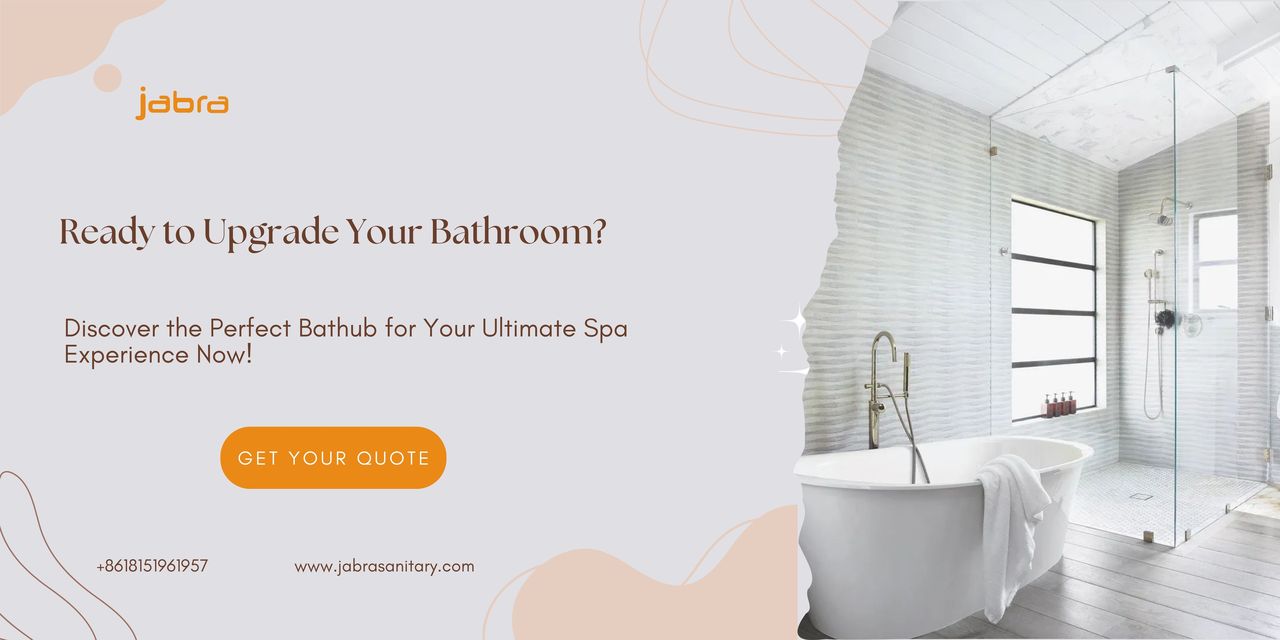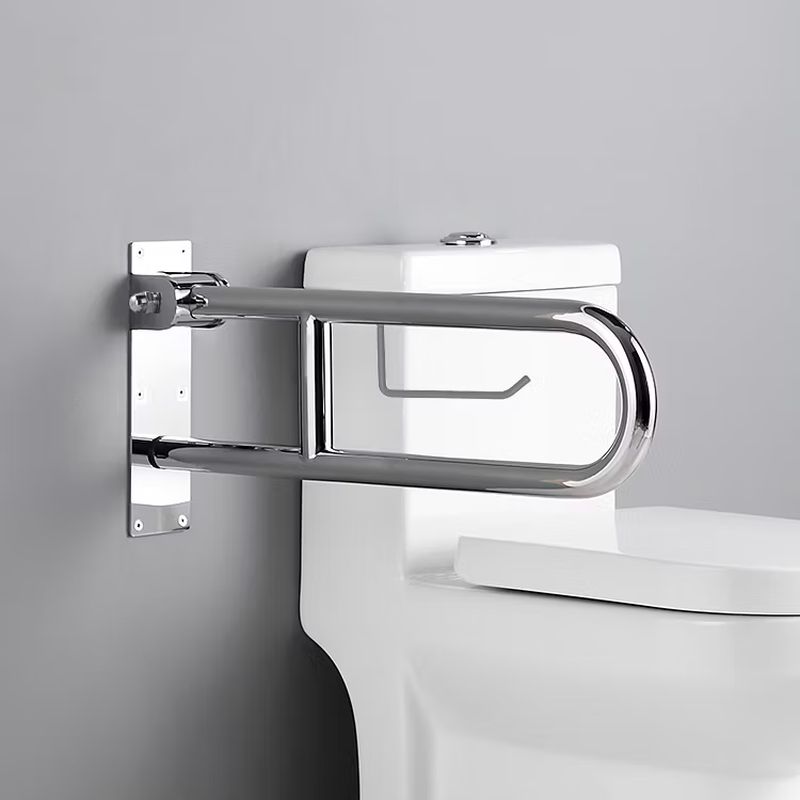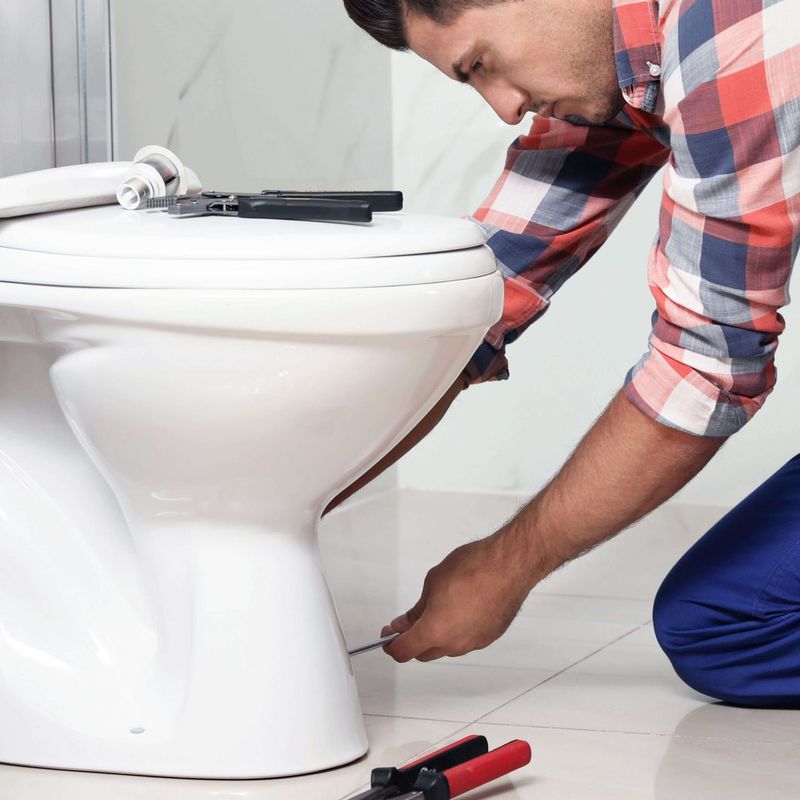 English
English
Jabra Sanitary is a sanitaryware supplier offering toilets, sinks, faucets, bathtubs, etc., at competitive prices. If you're a distributor, wholesaler, or project contractor, get a quote today!
 $23.9 Limited-time Offer
$23.9 Limited-time Offer Consignment Policy
Consignment Policy 20 Years of Experience
20 Years of Experience
Choosing the best type of tubs is a crucial aspect of any bathroom remodel. With various styles and materials available, it's essential to understand the pros and cons of each bathtub type to make an informed decision that suits your space, budget, and personal preferences.
This guide walks you through 10 types of bathtubs, 7 types of bathtub materials, and purchasing considerations.
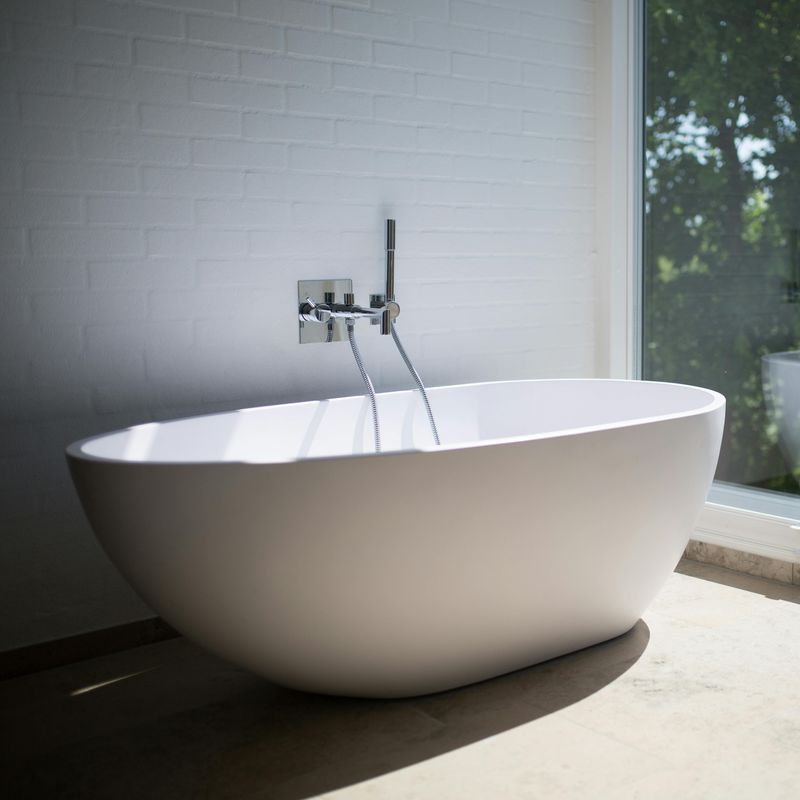
Table of Contents
Types Of Bathtubs
Types of Bathtub Materials
What to Consider Before Buying a New Bathtub
FAQs
Conclusion: Finding the Perfect Bathtub for Your Remodel
Types Of Bathtubs
First, let's explore the various types of bathtubs to find the perfect fit for your bathroom and lifestyle.
1. Freestanding Bathtubs
Freestanding bathtubs are the ultimate choice for anyone looking to make a bold style statement in their bathroom. These tubs are not attached to any walls, allowing them to be placed almost anywhere in the room.
They're ideal for creating a spa-like experience right in your home. Here are the pros and cons of this bathtub type:
Pros of Freestanding Bathtubs
- Eye-catching Design: Freestanding tubs are often the centerpiece of modern bathrooms due to their elegant and luxurious appearance.
- Versatile Placement: These tubs can be positioned wherever plumbing allows, giving you more creative freedom in your remodel.
- Material Variety: Available in acrylic, cast iron, and even stone, they cater to various aesthetics and budgets.
Cons of Freestanding Bathtubs
- Requires Space: These tubs typically need more room, making them less suitable for small bathrooms.
- Higher Cost: They're often more expensive to purchase and install than other options.
Before choosing a freestanding tub, check the weight of the material and ensure your flooring can support it. If you're on a tighter budget, consider acrylic freestanding tubs, which are lightweight and cost-effective.
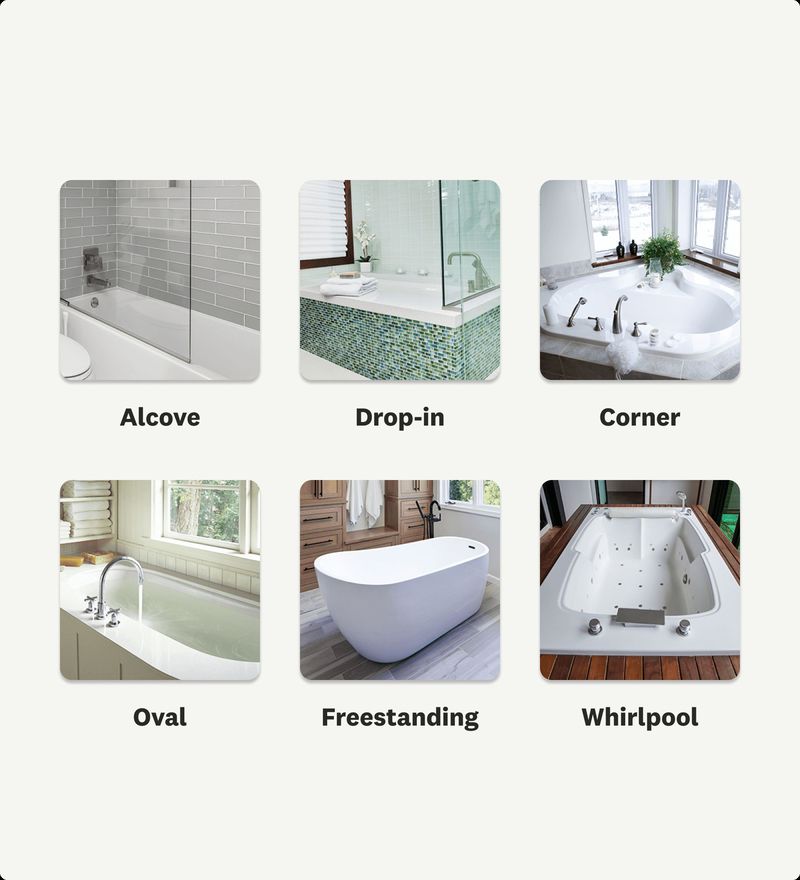
2. Alcove Bathtubs
Alcove bathtubs are one of the most popular choices for homeowners, thanks to their practicality and space-saving design. These tubs are installed between three walls, leaving only the front side exposed.
They're a common feature in traditional bathrooms and are perfect for smaller spaces. Here are the pros and cons of this type of bathtub:
Pros of Alcove Bathtubs
- Space-Efficient: Alcove tubs make excellent use of limited bathroom space, especially in smaller homes or apartments.
- Cost-Effective: These tubs are generally more affordable compared to other bathtub types.
- Easy Installation: Designed to fit snugly between walls, they are easier and faster to install.
- Shower Integration: Most alcove tubs are compatible with shower fixtures, making them a versatile option for families.
Cons of Alcove Bathtubs
- Limited Design Options: Since they are built for functionality, alcove tubs may lack the design appeal of freestanding or clawfoot tubs.
- Smaller Size: These tubs often come in standard sizes. They might not be ideal for taller individuals or those who prefer deeper soaking.
If you're choosing an alcove tub, look for models with built-in storage ledges or grab bars to add functionality and safety to your bathroom design.
3. Drop-In Bathtubs
Drop-in bathtubs are designed to be "dropped" into a pre-built platform or deck. The outer shell of the tub is fully encased, leaving only the interior visible.
This type of tub offers a seamless and customized look. Besides, it is perfect for homeowners looking to add a luxurious feel to their bathroom remodel. Here are the pros and cons of this bathtub type:
Pros of Drop-In Bathtubs
- Customizable Design: The surrounding platform can be customized with various materials like tile, marble, or wood, allowing you to match your bathroom's aesthetic.
- Seamless Appearance: Drop-in tubs blend effortlessly into your bathroom design, creating a clean and polished look.
- Comfortable: These tubs often come with ergonomic designs, including contoured interiors, for a more relaxing bathing experience.
- Extra Deck Space: The surrounding platform can provide additional space for storing bath essentials or even decor.
Cons of Drop-In Bathtubs
- Complex Installation: Building the platform and properly securing the tub requires more work, which can increase installation costs.
- Space Requirements: Drop-in tubs need enough room to accommodate the platform, making them less suitable for smaller bathrooms.
Notably, plan the platform design carefully to maximize both aesthetics and functionality. Ensure the platform material is water-resistant to prevent long-term damage.
4. Corner Bathtubs
Corner bathtubs are designed to fit snugly into the corner of a bathroom. They are an excellent choice for maximizing space while adding a touch of elegance.
These tubs often come in unique shapes, such as triangular or curved designs, making them visually appealing and practical. Here are the pros and cons of this type:
Pros of Corner Bathtubs
- Space-Saving Design: Perfect for bathrooms where space is limited, as they utilize corners effectively.
- Spacious Interior: Despite their compact footprint, many corner tubs offer enough room for two people. They are a great option for couples.
- Aesthetic Appeal: Their distinctive shape can add a modern or luxurious touch to your bathroom design.
Cons of Corner Bathtubs
Not Ideal for Smaller Bathrooms: While they save corner space, their wide dimensions might not fit in tiny bathrooms.
Higher Water Usage: Corner tubs often require more water to fill due to their larger size, which could increase utility costs.
If you're considering a corner tub, check your water heater's capacity to ensure it can handle the extra water required to fill the tub.
5. Soaking Bathtubs
Soaking bathtubs are designed for deep and full-body immersion, offering a relaxing and therapeutic bathing experience.
These tubs are typically deeper than standard bathtubs. They are perfect for those who prioritize relaxation over practicality. Here are the pros and cons of this type of bathtub:
Pros of Soaking Bathtubs
- Deep Immersion: Allow for full-body soaking, ideal for relieving stress and muscle tension.
- Simple Design: Often features sleek and minimalistic aesthetics that suit modern bathroom styles.
- Energy-Efficient: Many soaking tubs require less water than larger luxury tubs like jetted or corner tubs.
Cons of Soaking Bathtubs
- Not Multi-Functional: These tubs are primarily designed for soaking and may not accommodate shower fixtures easily.
- Higher Cost: Some models, especially freestanding soaking tubs, can be more expensive.
You can pair a soaking tub with a floor-mounted or wall-mounted faucet for a sleek and modern look. If space allows, consider placing the tub near a window or in a serene corner to enhance the bathing experience.
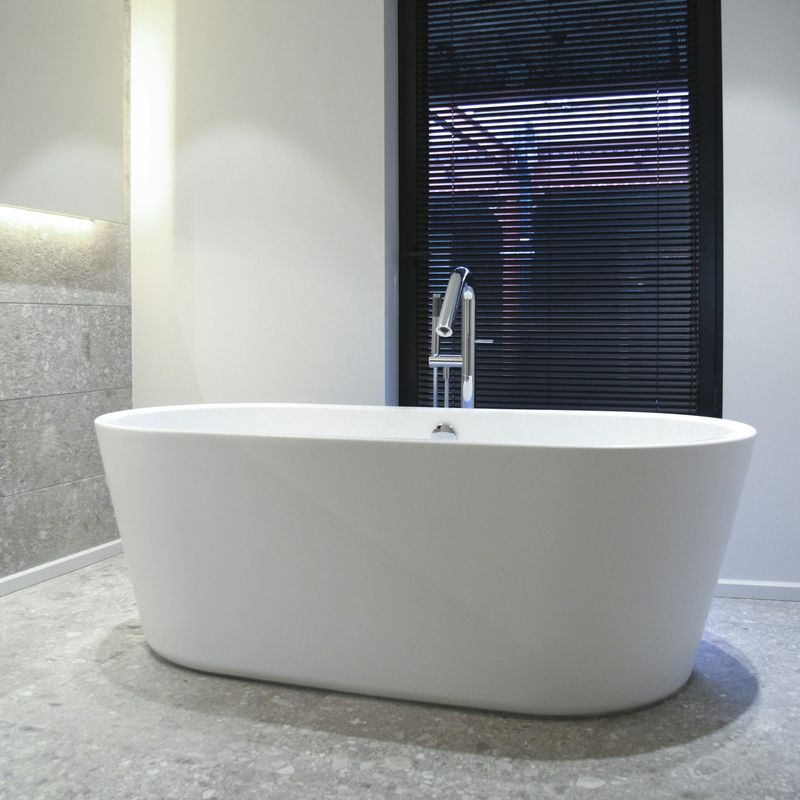
6. Jetted Bathtubs
Jetted bathtubs are equipped with built-in water jets that provide a therapeutic massage-like experience.
These tubs are a popular choice for homeowners looking to combine luxury and relaxation in their bathroom remodel. Here are the pros and cons of this type:
Pros of Jetted Bathtubs
- Therapeutic Benefits: The water jets help relieve muscle pain, improve circulation, and reduce stress.
- Luxury Appeal: Add a spa-like element to your bathroom, enhancing its overall value and appeal.
- Customizable Settings: Many jetted tubs allow you to adjust the pressure and direction of the jets for a personalized experience.
Cons of Jetted Bathtubs
- High Maintenance: The jets and plumbing system require regular cleaning to prevent buildup and ensure proper function.
- Higher Cost: Jetted tubs are typically more expensive to purchase and install compared to standard bathtubs.
- Noise: The motor for the jets can be noisy, which might not be ideal for all users.
Don't remember to regularly clean the jet system to avoid clogs and bacteria buildup. Look for models with self-cleaning features to simplify maintenance.
7. Whirlpool and Air Massage Tubs
Whirlpool and air massage tubs take luxury to the next level by offering advanced features for a spa-like bathing experience.
While whirlpool tubs use water jets, air massage tubs release streams of air for a gentler and full-body massage. Here are the pros and cons of this type:
Pros of Whirlpool and Air Massage Tubs
- Therapeutic Benefits: Both types are excellent for relaxation, easing muscle tension, and improving circulation.
- Customizable Features: Many models let you adjust the jet or air intensity.
- Modern Designs: These tubs often come in sleek and high-end styles that add a touch of elegance to your bathroom.
Cons of Whirlpool and Air Massage Tubs
- Higher Maintenance: Both types require frequent cleaning to keep the jets or air holes free from buildup.
- Costly: The advanced features and installation process make these tubs more expensive.
- Noise Levels: The motors can produce noise during operation, which might reduce the relaxation factor for some users.
If noise is a concern, look for tubs with quieter motors or soundproofing features. Be sure to factor in the extra cleaning requirements.
8. Walk-In Bathtubs
Walk-in bathtubs are designed with safety and accessibility in mind. They are an excellent choice for individuals with mobility challenges or families with elderly members.
These tubs feature an opening door, allowing users to step in without climbing over a high edge. Here are the pros and cons of this type:
Pros of Walk-In Bathtubs
- Safe Entry and Exit: The low threshold and door make them easy and safe to use for people with limited mobility.
- Built-In Safety Features: Many walk-in tubs include grab bars, anti-slip flooring, and built-in seats for added comfort and safety.
- Therapeutic Options: Some models come with features like hydrotherapy jets or air massage systems for added relaxation.
Cons of Walk-In Bathtubs
- Expensive: Walk-in tubs are often more expensive than standard models due to their specialized features.
- Longer Filling and Draining Time: Users must stay in the tub while it fills and drains.
- Space Requirements: These tubs may require more room than traditional alcove tubs, making them unsuitable for very small bathrooms.
When selecting a walk-in tub, look for features like quick-drain technology and temperature control to enhance the user experience.
9. Shower Bathtubs
Shower bathtubs combine the functionality of a bathtub and a shower into one unit, making them a versatile and space-saving option. They are an excellent choice for bathrooms to serve multiple purposes. Here are the pros and cons of this type:
Pros of Shower Bathtubs
- Versatility: Offer both bathing and showering options, catering to different preferences.
- Space-Efficient: Perfect for small bathrooms where separate shower and bathtub installations are not feasible.
- Budget-Friendly: Combine two features into one unit, saving on costs compared to installing a separate shower and tub.
Cons of Shower Bathtubs
- Limited Luxury: This may not provide the same aesthetic appeal or comfort as standalone tubs.
- Accessibility Concerns: Standard shower bathtubs may not be suitable for people with mobility issues, though some models include accessibility features.
- Consider adding a glass door or shower curtain for better water containment and a polished look. Opt for models with built-in shelving to store bath products conveniently.
10. Clawfoot Bathtubs
Clawfoot bathtubs are a timeless classic, known for their vintage charm and elegant design. These freestanding tubs are supported by decorative feet.
They are a popular choice for homeowners looking to add character to their bathrooms. Here are the pros and cons of this type:
Pros of Clawfoot Bathtubs
- Vintage Elegance: Add a touch of classic style and sophistication to any bathroom.
- Spacious and Comfortable: Many clawfoot tubs are designed for deep soaking, offering a luxurious bathing experience.
- Flexible Placement: Clawfoot bathtubs can be placed anywhere plumbing permits.
Cons of Clawfoot Bathtubs
- Heavy Weight: These tubs, especially those made of cast iron, are significantly heavier than other options and may require reinforced flooring.
- Higher Cost: Clawfoot tubs tend to be more expensive due to their unique design and high-quality materials.
- Maintenance: Cleaning underneath the tub can be challenging because of its exposed underside.
If you're concerned about the weight, consider acrylic clawfoot tubs, which are lighter and easier to install while maintaining the same classic look.
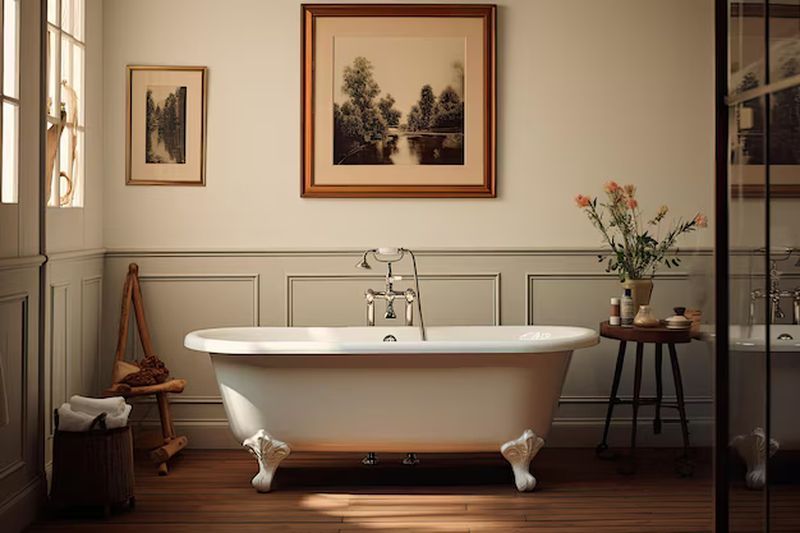
Types of Bathtub Materials
When choosing a bathtub, the material plays a critical role in determining its durability, maintenance needs, and overall appearance.
Here's a closer look at some common bathtub materials, along with their pros and cons:
1. Acrylic
Pros:
Lightweight, making it easy to install.
Affordable and widely available.
Resistant to chips and cracks compared to other materials.
Retain heat well, offering a comfortable soaking experience.
Cons:
Less durable over time, especially in high-use bathrooms.
Prone to scratches, though these can often be buffed out.
Best for:
Acrylic tubs are perfect for homeowners who want an affordable, stylish, and functional option without breaking the bank.

2. Fiberglass
Pros:
Extremely affordable, making it a budget-friendly option.
Lightweight and easy to install.
Simple to repair if cracks or chips occur.
Cons:
Prone to fading and discoloration over time.
Susceptible to cracking under heavy use or impact.
Less durable compared to other materials.
Best for:
Fiberglass is a great option for guest bathrooms or temporary installations where budget is the primary concern.
3. Enameled Steel
Pros:
Durable and has a glossy, smooth finish.
Affordable compared to premium materials like cast iron.
Resistant to scratches and stains.
Cons:
Chip easily if heavy objects are dropped onto it.
Conduct heat quickly, so it doesn't retain warmth as well.
Heavier than acrylic or fiberglass.
Best for:
Enameled steel bathtubs are a durable mid-range option. They are suitable for families who want a long-lasting material without the high cost of cast iron.
4. Cast Iron
Pros:
Exceptional durability, lasting for decades.
Retain heat well, keeping bathwater warm for longer.
Provide a luxurious and high-end look.
Resistant to scratches and dents.
Cons:
Extremely heavy, requiring reinforced flooring.
Expensive compared to other materials.
Difficult to install due to its weight.
Best for:
Cast iron tubs are an excellent choice for homeowners seeking timeless elegance and superior durability, especially for permanent installations.
5. Cast Polymer
Pros:
Highly customizable with various shapes, sizes, and finishes.
Offer a smooth and seamless appearance.
Durable and resistant to stains when properly maintained.
Cons:
Can be expensive, depending on customization.
Prone to surface damage if exposed to harsh cleaning chemicals.
Best for:
Cast polymer tubs are ideal for those who want a unique design for their bathroom aesthetic.
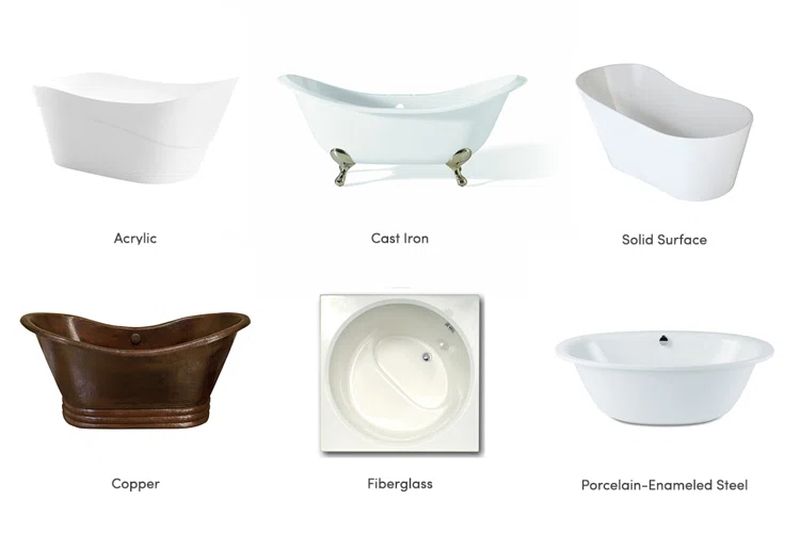
6. Stone
Pros:
Luxurious appearance.
Excellent heat retention, offering a relaxing soaking experience.
Incredibly durable and long-lasting.
Cons:
Extremely heavy, requiring professional installation and reinforced floors.
High cost, often reserved for luxury remodels.
Best for:
Stone tubs are the ultimate choice for luxury bathrooms, offering unparalleled aesthetics and performance.
7. Copper
Pros:
Natural antimicrobial properties, making it hygienic.
The unique and handcrafted appearance adds character to any bathroom.
Durable and resistant to corrosion.
Retain heat well for long and warm baths.
Cons:
Very expensive due to its handcrafted nature and material cost.
Requires regular maintenance to maintain its shine and prevent tarnishing.
Best for:
Copper tubs are perfect for homeowners seeking a statement piece that combines functionality with artistic flair.
What to Consider Before Buying a New Bathtub
Knowing these different types of bathtubs, now it is time to select your perfect fit. What type of bathtub is better?
Choosing the best bathtub involves more than just aesthetics. Here are key factors to consider before making your decision:
1. Style and Material
Decide on the bath tub styles that best suits your needs—freestanding, alcove, drop-in, or corner. Choose a material that fits your budget, durability expectations, and design preferences.
2. Size of Your Space
Measure your bathroom to ensure the tub fits comfortably. Be mindful of doorways, hallways, and other potential obstacles during installation. <Check bathroom standard size>
3. Water Heater's Capacity
Check that your water heater has enough capacity to fill the tub with warm water. Larger tubs may require water heater upgrades.
4. Floor's Weight Capacity
Heavy tubs like cast iron or stone require reinforced flooring. Consult with a professional to assess your bathroom's structural integrity.
5. How Will You Use the Bathtub?
Consider your primary use: relaxation, accessibility, or practical everyday use. This will guide you toward the right type of tub.
6. Special Features
Think about any additional features you want, such as whirlpool jets, air massage systems, or built-in seating.
7. Cost
Set a budget that includes not only the cost of the tub but also installation and any necessary structural changes.
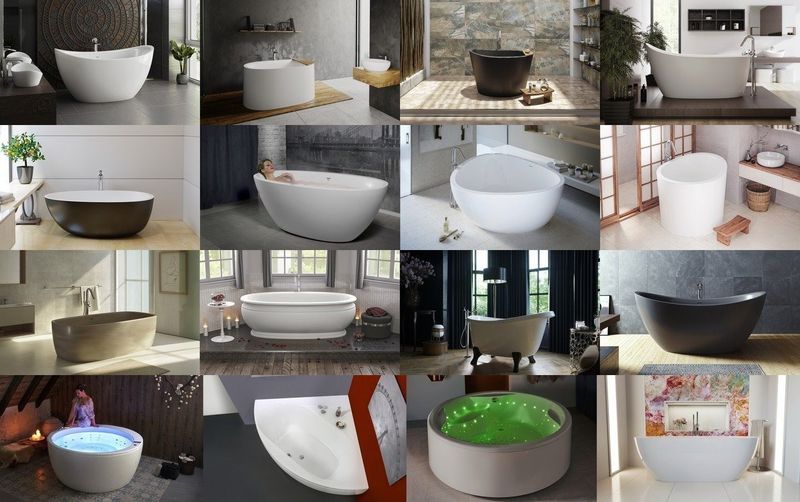
FAQs
Here are commonly asked questions about bathtubs:
What's the most comfy bathtub?
Soaking bathtubs are often considered the most comfortable bathtub type due to their depth and ergonomic design. They also allow full-body immersion for ultimate relaxation.
What's the most popular bathtub type?
Alcove bathtubs are widely favored for their practicality and efficient use of space, making this bath tub style a common choice for many homes.
What kind of tub is best for back pain?
Jetted or soaking tubs provide therapeutic benefits. They offer hydrotherapy or deep soaking to alleviate back pain and promote relaxation.
Which bathtub material is the best?
Two materials are top-rated:
Cast Iron: Known for its durability and heat retention.
Acrylic: Favored for its affordability and ease of maintenance.
What type of bathtub is better? Each material has its unique benefits, so it depends on your priorities and budget.
Which is better—an acrylic or fiberglass tub?
Acrylic tubs are generally more durable and aesthetically appealing compared to fiberglass, which is more prone to fading and cracking over time.
Conclusion: Finding the Perfect Bathtub for Your Remodel
Choosing the best type of tub for you is one of the most important decisions you'll make during your bathroom remodel. By understanding the pros and cons of different types of bathtubs, and different materials and their properties, you can make an informed decision that fits your style, budget, and needs.
When choosing the right bathtub for your bathroom, you can trust Jabra Sanitary, a leading toilet and bathtub manufacturer, for top-quality and innovative solutions to complement your home's style.







